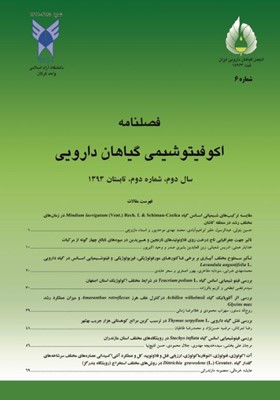بررسی فیتو شیمیایی اسانس گیاه Teucrium polium L. در شرایط مختلف اکولوژیک استان اصفهان
محورهای موضوعی : اکولوژی محیطیسیدمرتضی ابطحی 1 * , کریم باقرزاده 2
1 - استادیار، مرکز تحقیقات کشاورزی و منابعطبیعی استان اصفهان، اصفهان
2 - مربی، مرکز تحقیقات کشاورزی و منابع طبیعی اصفهان، اصفهان
کلید واژه: اصفهان, اسانس, رویشگاههای مختلف, مریم نخودی,
چکیده مقاله :
گیاه مریم نخودی (Teucrium polium L.) یکی از گونههای دارویی و معطر کشور است که مواد موثره آن علاوه بر کنترل بیماریهای قارچی و میکروبی، در صنایع آرایشی و بهداشتی نیز کاربرد دارد. هدف از این مطالعه بررسی اثر عوامل مختلف اکولوژیکی بر کمیت و کیفیت مواد موثره اسانس گیاه مریم نخودی در 10 رویشگاه مختلف استان اصفهان میباشد. بدینمنظور، پس از جمعآوری نمونه سرشاخههای گلدار گیاه از رویشگاههای مختلف، نسبت به اسانسگیری از آنها با روش تقطیر با آب و شناسایی و آنالیز اجزا اسانس با استفاده از دستگاه GC/MS انجام گرفت. نتایج عملیات میدانی نشان داد که رویشگاههای طبیعی گیاه در محدوده ارتفاعی 1095 تا 2455 متر، شیب 60-2 درصد، اقلیم استپی، نیمه استپی تا نیمه بیابانی با بارش سالانه 100 تا 600 میلیمتر و در خاکهای سبک تا سنگین و pH نسبتاً قلیایی و کم شور میباشد. اسانس گیاه در منطقه قهرود با بازده (3/1 درصد) از بالاترین مقدار برخوردار بود. ترکیب بتا-کاریوفیلن در مناطق سمیرم (27/47 درصد)، دران (33/20 درصد)، رامشه (48/18 درصد)، قهرود (15/18 درصد)، قمشلو (19/13 درصد) و چادگان (3/9 درصد) متغیر بود سپس ترکیب آلفا-پینن در مناطق هفتومان (46/20 درصد) و عروسان (48/11 درصد) و ماده موثره: ترانس- پینوکارول در نواحی نطنز (55/14 درصد) و انارک (30/13درصد) از بیشترین مقدار برخوردار میباشند. نتایج نشان داد که جمعیت مریم نخودی در منطقه قهرود، به لحاظ تولید اسانس و کیفیت مواد موثره، جهت کشت و تکثیر در مزارع با شرایط اقلیمی و خاکشناسی مشابه قابل توصیه میباشد.
10. Aburjai, T., Hudaib, M., and Cavrini, V. 2006. Composition of the essential oil from Jordanian germander (Teucrium polium L.). J. Essent. Oil Res., 18: 97-99.
11. Ashnagar A., Nahid, G.N. and Shahla, F. 2007. Isolation and identification of the major chemical components found in the Upper parts of Teucrium polium L. plants grown in Khuzestan province of Iran. Chinese Journal of chemistry. 25: 1171–1173.
12. Chopra, R.N., Nayar, S.L. and Chopra, I.C. 1996. Glossary of Indian medicinal plants (Including the supplement). Coucil of scientific and industrial research, New Delhi. 329p.
13. Dehghani, F., Khozani, T., Panjehshahin, M.R. and Karbalaedoost, S. 2005. Effect of Teucrium polium L. on histology and histochemistery in rat stomach. Indian journal of gastroenterology, 24:126-127.
14. Dirr, M.A. and Heuser, C.W. 1987. Woody plant propagation. Athens Ga. Varsity press. 239p.
15. Esmaeili, M.A. and Yazdanparast, R. 2004. Hypoglycaemic effect of Teucrium polium: studies with rat pancreatic islets. J. Ethnopharmacol. 95: 27–30
16. Ferriol, M., Perez, I., Merle, H. and Boira, H. 2006. Ecological germination requirements of the aggregate species Teucrium pumilum (Labiatae) endemic to Spain. Plant and Soil. 284(1-2):205-216.
17. Jaimand K., Rezaee M.B., Soltanipoor, M.A. and Mozaffarian, V. 2006. Volatile constituents of Teucrium stocksianum Boiss. sp. Stocksianum from Iran J. Essent. Oil Res., 18: 476-477.
18. Jalali. E.O., Olivier, V., Suzette, P., and Yves Dubuisson, J. 1997. Utility of rDna ITS sequences in the systematic of Teucrium section Polium. Journal of plant systematic and evolution. 215:1-4.
19. Mukarram shah, S.M., Ullah, F., Hasan shah, S.M., Zahoor, M. and Sadiq, A. 2012. Analysis of chemical constituents and anti nociceptive potential of essential oil of Teucrium Stock sianum bioss collected from the North West of Pakistan, BMC Complementary and Alternative Medicine, 12:244
20. Najafi, F., Bannayan, M. Tabrizi, L. and Rastgoo, M. 2006. Seed germination and dormancy breaking techniques for Ferula gummosa and Teucrium polium L. Journal of arid environments. 64(3):542-547.
21. Nematollahi-Mahani, S.N., Rezazadeh-Kermani, M. and Nakhaee, N. 2007. Cytotoxic effects of Teucrium polium L. on some established cell lines. Journal of pharmaceutical. 45(4):295-298
22. Predrag L., Dakwar, S., Portnaya, I., Cogan, U., Azaizeh, H. and Bomzon, A. 2006. Aqueous extracts of Teucrium polium L. Possess remarkable antioxidant activity in vitro. Evidence based complementary and Alternative medicine (Oxford journal). 3(3):329–338.
23. Strakis, I., Siagris, A., Dimitrios, A., Leonidou, L., Mazokopakis, B., Tsamandas, B., Karatza, C. and Chrysoula, A. 2006. Hepatitis caused by the herbal remedy Teucrium polium L. European journal of Gastroenterology & Hepatology. 18(6):681-683.
24. Tariq, M. Ageel, A.M., Al-Yahyas, M.A., Mossa J.S. and Al-Said, M.S. 1986. Anti inflammatory activity of Teucrium polium L. Int. Journal Tissue React. 11:185–8.

